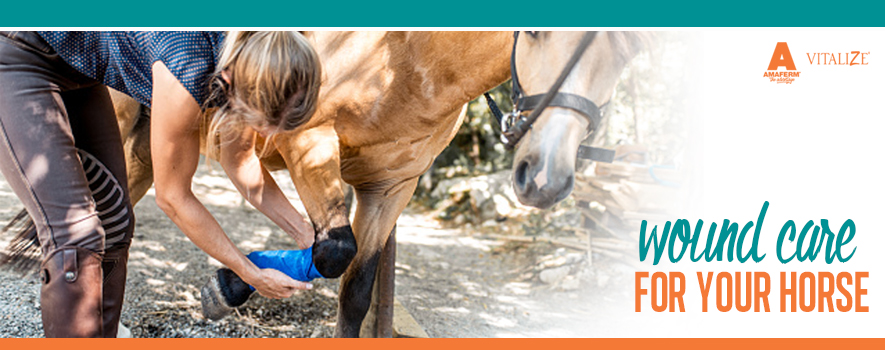
Whether you ride for pleasure, sport or work, chances are your horse will experience a leg wound sooner rather than later. Knowing how to care for and treat that wound with is key to keeping your horse healthy and performing its best.
Perhaps the most important consideration before bandaging a wound is making sure that wound is cleaned thoroughly to prevent infection. Taylor Ruether, BioZyme® Inc. Area Sales Manager and avid team roper, says she always runs cold water from a hose over the wound for 10-15 minutes to clean the wound as well as reduce the swelling and pain. She doesn’t use a nozzle, but lets the water run in gentle stream and starts the water running down about an inch above the wound. Once the wound is cleaned and dried, apply a salve to the wound to help it heal. For a minor scrape, iodine or a disinfectant ointment is the best option; for a deep tissue wound, consult your veterinarian for an antibiotic.
When bandaging your horse, the handler’s safety is of utmost importance. Remember your horse is in pain, and you will be touching a sensitive area, so make sure you stay safe. Ruether recommends standing parallel to your horse, facing its head.
Once you are ready to start bandaging your horse, first apply a disinfectant gauze pad to protect the wound. Then, use vet wrap to start bandaging the horse’s leg by starting at the inside bottom of the leg about a half-inch below the gauze wrap, and working your way up in a clockwise motion. Once you have wrapped the leg all the way up and one full wrap past the top of the pad, wrap it back down and make one full wrap below the bottom of the pad, and tear or cut the vet wrap and secure it. Vet wrap is beneficial because it is sterile, when taken from a new package, and it is self-adhering. It also offers flexibility and moves with the horse. Be sure to wrap the leg so the bandage will stay; you don’t want it so tight it cuts off circulation, but you don’t want it too loose so it slides around either. Ruether suggests making it tight enough to stretch slightly, but not tight enough to put your finger between the leg and the wrap.
You should change the bandage on your horse twice daily for the first week, according to Ruether. This give you a chance to make sure the wound stays clean and to check its healing progress. Each time you remove the bandage, run cold water over the wound to “ice down” the area to help it heal and to keep it clean. Depending on the severity of the wound, you will want to remove the bandage once a scab forms to speed up the healing process; however, continue to clean the wound with cold water and treat with the ointment or salve recommended by your vet.
“If you aren’t for sure how deep the wound is or what part of the leg it is on, have your vet look at your horse,” Ruether said. “Let the vet examine and clean out the wound initially to get rid of any infection if you aren’t sure what the wound is.”
When treating your horse with a wound, Ruether recommends also providing them with Vitalize® Equine Recovery Paste (transitioned to Vitalize® Equine Recovery Gel July 2019) as soon as the injury happens and for at least a couple of days, depending on the severity of the wound. The recovery gel will help relieve the increased stress on the horse as the immune system goes into overdrive to heal the wound.
“Every time a horse injures itself it causes stress to its body, and that stress may cause more than just the outside physical wound,” Ruether said. “Jump start your horse to health with Vitalize Recovery Paste.”


